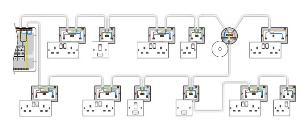On Wednesday 31st October 2007, a public meeting was held in the Council Chamber at Savoy Place, London - home of the IET, to discuss the perceived merits and shortcomings of ring final circuits. The meeting was well attended with an audience of approximately 100 people.

The programme for the meeting was as follows:
- Introduction by Chairman Mr N C Friswell
- The History of the Ring Circuit by Mr D W M Latimer
- 2.40pm Disadvantages of the Ring Circuit by Mr H R Lovegrove
- 3.10pm Advantages of the Ring Circuit by Mr M White
- 3.40pm Comfort Break (10 mins)
- 3.50pm General Discussion & Comments
- 4.40pm Chairman’s Summary
All three papers were well received. Some of the main points that came out of the meeting were as follows:
1. Earth Continuity – advantage of the ring circuit?
The presentation by Mr White claimed that if one cpc was to become disconnected at a point around the ring, there would still be earth continuity (albeit of higher resistance) via the remaining cpc at each socket-outlet within the circuit. To this extent, the ring circuit is safer than the radial circuit. It is acknowledged that loss of the earth conductor on a radial circuit may not be noticed until a shock is received.
2. Ring circuits – less protective devices needed?
Another positive attribute claimed for ring circuits was reduction in the number of protective devices needed at distribution boards when compared to radial circuits.
3. Amount of copper used in an installation?
The presentation by Mr Lovegrove claimed that radial circuits offer greater flexibility, require the use of less cable, shorter installation time, lower installation cost and a smaller drain on the world’s resources of copper.
Conversely, the presentation by Mr White claimed one of the primary aims when ring circuits were developed after the Second World War was to minimise the use of copper in the face of shortages of materials during the massive reconstruction that was required following the cessation of hostilities. It was agreed that both ring and radial circuits may both be best suited to certain applications.
4. Testing and quality of workmanship?
The presentation by Mr Lovegrove claimed numerous disadvantages of the ring circuit including:
- difficulty in complying with Regulation 433-02-04 (433.1.5 in the 17th Edition) concerning distributing the load evenly in a ring circuit,
- lack of training to familiarise electricians from other countries to a wiring practice that is not common in other countries,
- susceptibility to fault conditions from additions and alterations to the circuit,
- testing and fault finding is more time consuming and costly,
- fault conditions are not apparent when in use.
On the other hand, the presentation by Mr White claimed that the ring circuit has proved its value over the last 60 years. The testing regime has been proven to work effectively and problems seldom arise on either ring or radial circuits if they are installed and tested correctly.
Mr Lovegrove’s view on the potential problems that could be attributed to ring circuits received support from the floor however, a number of people held the view that ring circuits did not present a problem on larger projects that are designed and specified by consultants, who monitor the installations as they progress and ensure testing is carried out properly by electricians who are skilled and competent. Better training of electricians is required.
5. EMC issues
Some members of the audience raised the issue of EMC and ring circuits if the circuit was not installed and tested correctly. It was stated that this issue is the subject of a report being produced by a group of experts of the Stakeholder Advisory Group on ELF EMFs (SAGE).
CONCLUSIONS
To summarise the following points arose from this meeting:
- both ring and radial final circuits have their place in a modern electrical installation and neither circuit layout should be used to the exclusion of the other
- more guidance on these circuit arrangements is required in IEE Guidance Notes
- Better initial training was required for persons working in the electrical installation industry, including domestic installers
